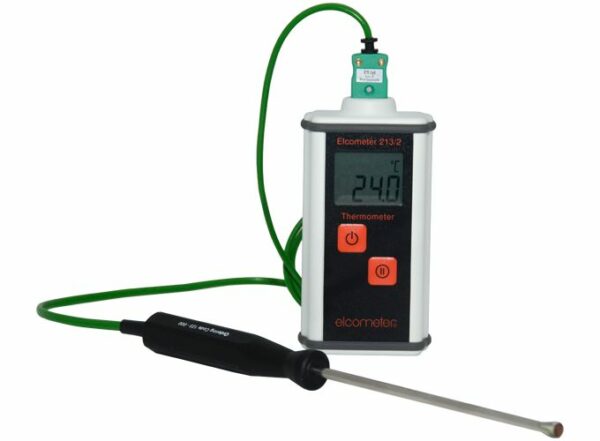Home » Products » Coating Inspection » Climatic Condition Testing » Temperature Gauges » Elcometer 213-2 Digital Waterproof Thermometer
Elcometer 213-2 Digital Waterproof Thermometer

Product Description
The Elcometer 213/2 is a simple, easy-to-use digital thermometer for quick and easy measurements of surface, air and liquid temperature as well as the temperature of soft materials.
The Elcometer 213/2 Digital Waterproof Thermometer offers the latest microprocessor technology, superior durability and is designed for reliability and ease of use.
Features of the Elcometer 213/2 Digital Waterproof Thermometer
• Rubber bumper seals for impact resistance
• Waterproof case (IP66 & IP67 protection)
• Extruded Aluminium case for superior durability
• °C/°F switchable
• Easy to read LCD display
Probes are available to purchase separately.
Specifications
| Part Number | Description | Certificate |
| G213—-2 | Elcometer 213/2 Digital Waterproof Thermometer* | ο |
| Operating Range† | -49°C to +1,372°C | |
| Accuracy | ±1% of the reading ±1 digit | |
| Resolution | 0.1°C up to 299.9°C, 1°C above 299.9°C | |
| Battery Life | 5,000 hours | |
| Power Supply | 1 x MN1604/PP3 (9V) battery | |
| Dimensions | 35 x 60 x 115mm | |
| Weight | 194g |
* Probes are not supplied as standard with the Elcometer 213/2 Digital Waterproof Thermometer
† Operating range is dependent on probe used
ο Optional Calibration Certificate available
Data Sheet
Accessories
| Probe | Part Number | Description | Range |
| T99911728 | Magnetic Surface Probe; 13mm diameter | -50 to 150ºC | |
| T2136069 | Surface Probe; 130 x 4.2mm diameter | -50 to 600ºC | |
| T9996390 | Liquid Probe; 130 x 3mm diameter | -200 to 1100ºC | |
| T2136391 | Needle Probe; 130 x 3mm diameter | -50 to 400ºC |
Other probes available on request.
Video
If climatic conditions; such as surface temperature, air temperature, relative humidity, wet bulb temperature, dry bulb temperatre, dewpoint temperature, and the Delta T; are wrong at the time of applying a coating, this could cause coating failure.
That’s why it’s vital to monitor a range of climatic parameters before and during the coating application process, to ensure your coating can have a successful service life.
So what climatic parameters do we measure, why do we measure them, and how?
Contents
0:00 – Introduction
0:50 – What climatic conditions do we measure?
1:48 – Why do we measure climatic conditions?
3:58 – How do we measure climatic conditions?
4:20 – How to use a Whirling Hygrometer / Sling Psychrometer
8:29 – Using a surface temperature thermometer
10:03 – Elcometer 319 Dewpoint Meter
The key climatic parameters include:
• Surface temperature (Ts), the temperature of the surface to be painted;
• Air temperature (Ta), the temperature of the air surrounding the surface to be painted;
• % Relative Humidity (RH), the amount of water vapour present in the air compared to the maximum possible, expressed as a percentage;
• Wet bulb temperature (Twb), the air temperature as read by a thermometer that’s covered in water-soaked fabric over which air is passed;
• Dry bulb temperature (Tdb), the temperature that is usually thought of as air temperature;
• Dewpoint (Td), the temperature at which moisture condenses on a surface, calculated from the air temperature and % Relative Humidity;
• And the Delta T (TΔ), the difference between the surface temperature (Ts) and the dewpoint temperature (Td).
While it’s important to monitor all of these parameters, special attention should be paid to surface temperature and relative humidity, as most paint data sheets will specify acceptable ranges of these parameters in which the paint can be applied.
However, by far the most important parameter of all is the Delta T, as it tells you the difference between the surface temperature and the dewpoint temperature. The smaller the difference, the more likely that moisture (or dew) will have condensed on the surface.
It is generally accepted within the industry that the Delta T should be at least 3°C or higher for the coating to be applied.
How do you actually measure and calculate the key climatic parameters? There are two main methods you can follow.
The traditional method requires multiple pieces of equipment to complete.
The first piece required is the whirling hygrometer, also known as a sling psychrometer, and it is used to measure the wet bulb and dry bulb temperatures. These temperatures are then used to work out the dewpoint and relative humidity. Elcometer provides two types of hygrometer, but they work in pretty much the same way.
Hygrometers consist of two liquid filled thermometers positioned side-by-side in a rotating body. One thermometer is covered with a fabric “sock” or “wick” connected to a reservoir (this measures your wet bulb temperature), while the other is uncovered (this measures your dry bulb temperature).
Once you have your results, typically conversion tables are then used to determine the relative humidity and dewpoint temperature, like the ones supplied with the Elcometer 116 Hygrometers. Alternatively, the Elcometer 114 Dewpoint Calculator provides a quick and easy way to determine these values, and we show you how it works in our Elcometer 114 video: https://youtu.be/HLbuapAnoqA
However you are still missing the all-important Delta T measurement, and to calculate this, you still need a surface temperature measurement – something a hygrometer can’t provide, meaning you’ll need a separate surface thermometer. Once you have your surface temperature, subtract your dewpoint temperature from it, and you have the Delta T.
However there is a quicker and simpler method, without sacrificing on accuracy.
The Elcometer 319 Dewpoint Meter is a digital gauge that can monitor and record all of the key climatic parameters simultaneously, telling you if conditions are suitable for painting. What’s more it can continuously monitor and log the conditions as you paint, and instantly alarm if one of the parameters falls outside of the specified range.
